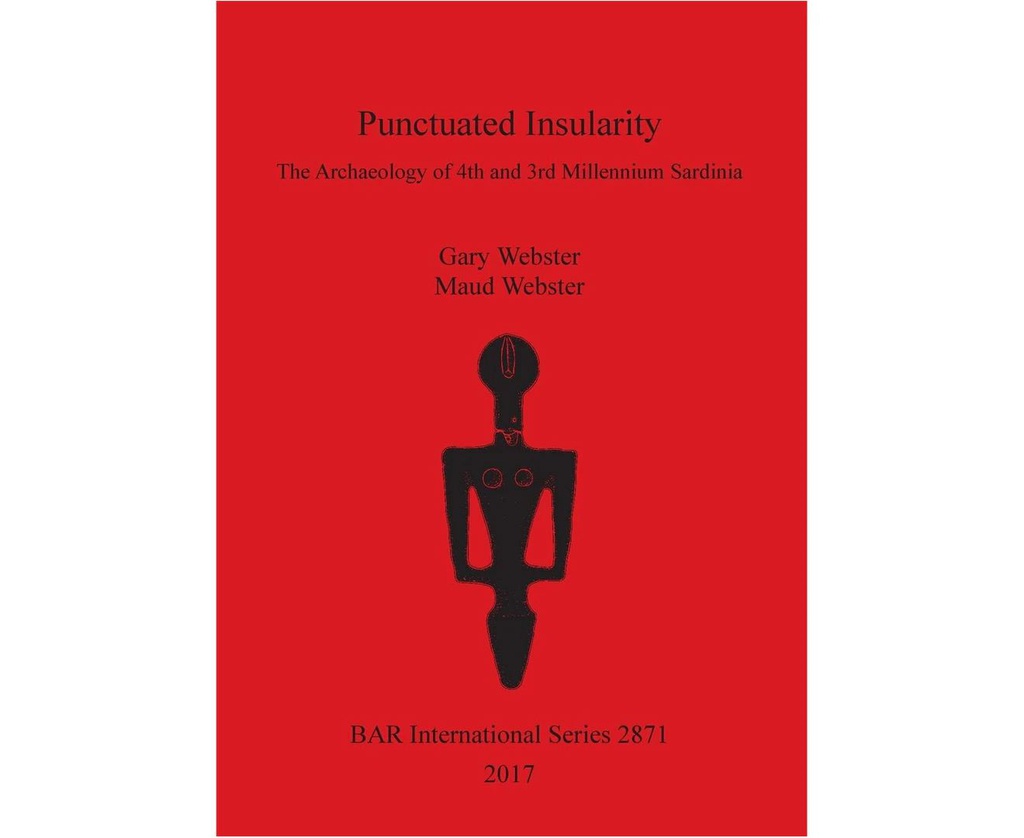Sardinia preserves an exceptional record of its
Final Neolithic and Copper Age cultures, with a diverse crafts repertory,
henges and dolmens, statue-menhirs, chamber tombs - and the only known ziggurat
in Europe. The present study provides a synthesis in English for a scholarly
readership interested in Mediterranean adaptations during this earliest period
of metallurgy. As elsewhere, the infusion of metallurgy had profound
implications, as island cultures underwent a series of transformations tied
directly or indirectly to it. Spanning two millennia, these changes are studied
in terms of material cultures known as Ozieri, Sub-Ozieri, Filigosa-Abealzu,
Monte Claro and Bell Beaker. A more overarching finding from this review is the
periodic engagement between these cultures and geographically distant ones.
Such punctuations of the insular condition had long-lasting effects on local
expression, and some thoughts on how this might contribute to understandings of
concepts like identity formation are presented by way of a conclusion. This
book is a companion volume to The Sardinian Neolithic: An Archaeology of the
6th and 5th Millennia BCE by Gary Webster (2019).
Publisher: BAR Publishing
Published: United
Kingdom, 31 October 2017
Format: Paperback, 174
pages
Dimensions: 29.7 x 21 x
1.2 centimeters (0.68 kg)
Writer: Gary S.
Webster, Maud Webster
Table of Contents
LIST
OF ILLUSTRATIONS ABSTRACT CHAPTER 1. INTRODUCTION The landscape The metal
resources Archaeological record and archaeological culture Archaeological
culture as cultural modality Insularity CHAPTER 2. OZIERI, EARLY 4TH MILLENNIUM
BC Oriental engagement Defining Ozieri: the diagnostic pottery Eastern forms
Other Ozieri crafts Lithics Metal Textiles Ozieri settlement Ozieri subsistence
Tombs and mortuary practices Mortuary cave: Sa Ucca de su Tintirriolu Domus de
Janas The interred Interpreting burial practices The Sanctuaries of Monte
d'Accoddi Menhir-shrine phase Red Temple phase Ozieri imagery The ram The bull
Anthropomorphic imagery Composite images Discussing cult expression
Interpreting Ozieri CHAPTER 3. SUB-OZIERI, LATE 4TH MILLENNIUM BC Adaptive insularity
Defining Sub-Ozieri: the diagnostic pottery Common ware Fine ware Other
Sub-Ozieri crafts Textiles Lithics Bone and shell Metal Sub-Ozieri settlement
Sunken-hut villages Cave camps Sub-Ozieri subsistence Su Coddu Canelles Tombs
and mortuary practices The sanctuary of Monte d'Accoddi Interpreting Sub-Ozieri
CHAPTER 4. FILIGOSA-ABEALZU, 3RD MILLENNIUM BC Revival and re-engagement
Defining Filigosa-Abealzu: the diagnostic pottery Exotic styles Other
Filigosa-Abealzu crafts Metal Lithics Textiles Bone, horn, shell
Filigosa-Abealzu imagery Anthropomorphic figures Multi-limbed creatures
"Candelabra" Cup-marks Filigosa-Abealzu settlement Open villages
Fortified sites Filigosa-Abealzu subsistence Tombs and mortuary practices Domus
de janas Dolmens and megalithic cist Shrines and sanctuaries Cave- or
rock-shelter sanctuaries Menhir cenotaphs Megalithic henges Temple sanctuary:
Monte d'Accoddi Interpreting Filigosa-Abealzu Revival Re-engagement CHAPTER 5.
MONTE CLARO, MID-LATE 3RD MILLENNIUM BC Indigenous alterity Defining Monte
Claro: the diagnostic pottery Production methods Decorative surface treatments
Decorative patterns The diagnostic Monte Claro repertory Filigosa-Abealzu/Monte
Claro hybridity Other Monte Claro crafts Metal Lithics Textiles Monte Claro settlement
Open settlements Fortifications: Monte Baranta Camps and settlements of the
northeast islands Monte Claro subsistence Tombs and mortuary practices Shaft
tombs Other pithos-sherd burials Full pithos burial: Scaba 'e Arriu
Reconstructing burial practices Monte Claro sanctuaries Sa Sedda de Biriai
Interpreting Monte Claro Origins and agencies Social correlates of Monte Claro
CHAPTER 6. BELL BEAKER, LATE 3RD MILLENNIUM BC Exotic incursions Defining Bell
Beaker: the diagnostic pottery Forms and motifs Chronology and local
convergences Other Bell Beaker crafts Metal Lithics Bone and shell Bell Beaker
habitations Bell Beaker subsistence The forensic evidence from Padru Jossu
Tombs and mortuary practices Conformity and contrast Interpreting Bell Beaker
Modelling the Bell Beaker phenomenon A Sardinian Beaker-incursion model End
note CHAPTER 7. CONCLUDING DISCUSSION A punctuated insularity BIBLIOGRAPHY
About the Author
Gary
Webster is a doctor of anthropology (PhD from Penn State University) and a
docent of archaeology (Umea University). He has published widely on theoretical
issues as well as on archaeological field work, especially related to Bronze
Age Sardinia. Maud Webster holds an MA in classical archaeology and ancient
history from Uppsala University. Her research interests include Sardinian pre-
and protohistory, and she has also written widely on Italian history.
Reviews
'Presents
an up-to-date overview of our knowledge about the Chalcolithic cultures of
Sardinia and tackles several areas of research which are poorly understood and
remain areas of debate, in a manner which is not limited to literature review,
but includes also constructive critique of different interpretations of various
aspects of evidence from the Copper Age Sardinia.' Cezary Namirski, Durham
University 'There are no comparable syntheses, either in English or other
languages, on the topic of Copper Age Sardinia. This is therefore a welcome
addition to the somewhat limited English-speaking academic production on
Sardinia, which, moreover, covers a much-neglected phase in the local
prehistoric sequence.' Peer Reviewer 'This book reflects, in a very accurate
way, the state-of-the-art specialist literature and shows deep knowledge of
Sardinian prehistory on the part of the authors. It is a useful synthesis of
research, which discusses one of the richest prehistoric cultural contexts of
the Mediterranean.' Peer Reviewer



![[CH_0557] AB-SA-RA-KA OR WYOMING OPENED PAPERBACK BOOK](/web/image/product.product/1144/image_1920/300x300/%5BCH_0557%5D%20AB-SA-RA-KA%20OR%20WYOMING%20OPENED%20PAPERBACK%20BOOK?unique=517872d)
![[CH_0517] CHOLAS IN BOWLERS: JOURNEY TO BOLIVIA JANE MUNDY PAPERBACK BOOK](/web/image/product.product/1104/image_1920/300x300/%5BCH_0517%5D%20CHOLAS%20IN%20BOWLERS:%20JOURNEY%20TO%20BOLIVIA%20JANE%20MUNDY%20PAPERBACK%20BOOK?unique=afa4c7b)
![[CH_0550] ENGLISHMAN'S TRAVELS IN AMERICA PAPERBACK BOOK](/web/image/product.product/1137/image_1920/300x300/%5BCH_0550%5D%20ENGLISHMAN%27S%20TRAVELS%20IN%20AMERICA%20PAPERBACK%20BOOK?unique=07fd19f)
![[CH_0551] GOVERNING THE NORTH AMERICAN ARCTIC PAPERBACK BOOK](/web/image/product.product/1138/image_1920/300x300/%5BCH_0551%5D%20GOVERNING%20THE%20NORTH%20AMERICAN%20ARCTIC%20PAPERBACK%20BOOK?unique=3dda7d9)
![[CH_0557] AB-SA-RA-KA OR WYOMING OPENED PAPERBACK BOOK](/web/image/product.product/1144/image_128/%5BCH_0557%5D%20AB-SA-RA-KA%20OR%20WYOMING%20OPENED%20PAPERBACK%20BOOK?unique=517872d)
![[CH_0517] CHOLAS IN BOWLERS: JOURNEY TO BOLIVIA JANE MUNDY PAPERBACK BOOK](/web/image/product.product/1104/image_128/%5BCH_0517%5D%20CHOLAS%20IN%20BOWLERS:%20JOURNEY%20TO%20BOLIVIA%20JANE%20MUNDY%20PAPERBACK%20BOOK?unique=afa4c7b)
![[CH_0550] ENGLISHMAN'S TRAVELS IN AMERICA PAPERBACK BOOK](/web/image/product.product/1137/image_128/%5BCH_0550%5D%20ENGLISHMAN%27S%20TRAVELS%20IN%20AMERICA%20PAPERBACK%20BOOK?unique=07fd19f)
![[CH_0551] GOVERNING THE NORTH AMERICAN ARCTIC PAPERBACK BOOK](/web/image/product.product/1138/image_128/%5BCH_0551%5D%20GOVERNING%20THE%20NORTH%20AMERICAN%20ARCTIC%20PAPERBACK%20BOOK?unique=3dda7d9)